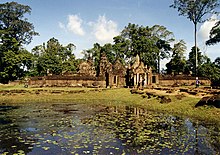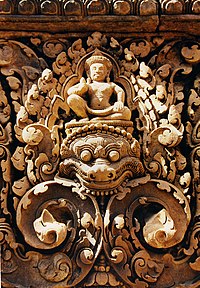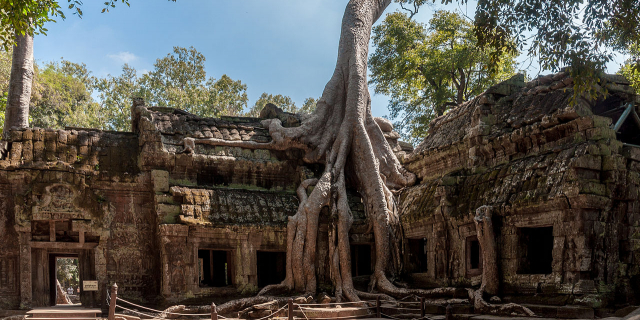Banteay Srei (Khmer: បន្ទាយស្រី [ɓɑntiəj srəj]) is a 10th-century Hindu temple in Siem Reap, Cambodia dedicated to Shiva and Parvati. Located in the area of Angkor, it lies near the hill of Phnom Dei, 25 km (16 mi) north-east of the main group of temples that once belonged to the medieval capitals of Yaśodharapura and Angkor Thom. Banteay Srei is built largely of red sandstone, a medium that lends itself to the elaborate decorative wall carvings which are still observable today. The buildings themselves are miniature in scale, unusually so when measured by the standards of Angkorian construction. These factors have made the temple extremely popular with tourists, and have led to its being widely praised as a "precious gem", or the "jewel of Khmer art".
 "Bantãy Srĕi" ("Citadel of Women") is the modern name of a 10th-century Khmer temple originally called "Tribhuvanamaheśvara" ("Great Lord of the Threefold World"),[1] an appellation of the god Shiva.
"Bantãy Srĕi" ("Citadel of Women") is the modern name of a 10th-century Khmer temple originally called "Tribhuvanamaheśvara" ("Great Lord of the Threefold World"),[1] an appellation of the god Shiva.Consecrated on 22 April 967 AD,[2] Bantãy Srĕi was the only major temple at Angkor not built by a monarch; its construction is credited to the courtiers named Vishnukumara and Yajnavaraha[3]: 367 / Yajñavarāha (modern Khmer: យជ្ញវរាហៈ), who served as a counsellor to king Rajendravarman II (modern Khmer: ព្រះបាទរាជេន្រ្ទវរ្ម័ន). The foundational stela says that Yajnavaraha, grandson of king Harsavarman I,[4]: 117 was a scholar and philanthropist who helped those who suffered from illness, injustice, or poverty.[5] His pupil was the future king Jayavarman V (r. 968 – ca. 1001). Originally, the temple was surrounded by a town called Īśvarapura.
 Banteay Srei is known for the intricacy of its carvings. This carving is of a Kala, a mythical creature representative of time and of the god Siva.
Banteay Srei is known for the intricacy of its carvings. This carving is of a Kala, a mythical creature representative of time and of the god Siva.Yajñavarāha's temple was primarily dedicated to the Hindu god Shiva. Originally, it carried the name Tribhuvanamaheśvara—great lord of the threefold world—in reference to the Shaivite linga that served as its central religious image.[6] However, the temple buildings appear to be divided along the central east–west axis between those buildings located south of the axis, which are devoted to Śiva, and those north of the axis, which are devoted to Vishnu.
 It has been speculated that the temple's modern name, Bantãy Srĕi, is due to the many devatas carved into the red sandstone walls.
It has been speculated that the temple's modern name, Bantãy Srĕi, is due to the many devatas carved into the red sandstone walls.The temple's modern name, Bantãy Srĕi—citadel of the women, or citadel of beauty—is probably related to the intricacy of the bas relief carvings found on the walls and the tiny dimensions of the buildings themselves.[6] Some have speculated that it relates to the many devatas carved into the walls of the buildings.[7]
Expansion and rededicationBantãy Srĕi was subject to further expansion and rebuilding work in the eleventh century.[8]: 96 At some point it came under the control of the king and had its original dedication changed; the inscription K 194 from Phnoṃ Sandak, dated Monday, the 14th or 28 July 1119 AD records (line B 13) the temple being given to the priest Divākarapaṇḍita and being rededicated to Shiva.[9] It remained in use at least until the fourteenth century according to the last known inscription K 569, dated Thursday, 8 August 1303 AD.[10]
RestorationThe temple was rediscovered in 1914 and was the subject of a celebrated case of art theft when André Malraux stole four devatas in 1923 (he was soon arrested, and the figures were returned).[11] The incident stimulated interest in the site, which was cleared the following year.
In the 1930s Banteay Srei was restored through the first important use of anastylosis at Angkor whereby a ruined building or monument is restored using the original architectural elements to the greatest degree possible. Until the discovery of the foundation stela in 1936, it had been assumed that the extreme decoration indicated a later date than was the case.[12]
To prevent the site from water damage, the joint Cambodian-Swiss Banteay Srei Conservation Project installed a drainage system between 2000 and 2003.[13] Measures were also taken to prevent damage to the temples walls from nearby trees.[14]
Unfortunately, the temple has been ravaged by pilfering and vandalism. When, toward the end of the 20th century, authorities removed some original statues and replaced them with concrete replicas, looters took to attacking the replicas. A statue of Shiva and his shakti Uma, removed to the National Museum in Phnom Penh for safekeeping, was assaulted in the museum itself.[15]































Add new comment